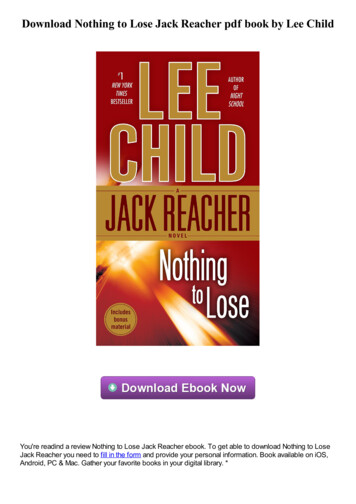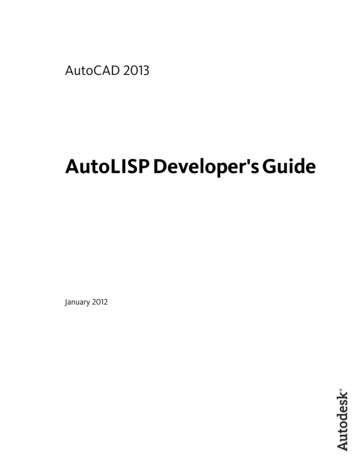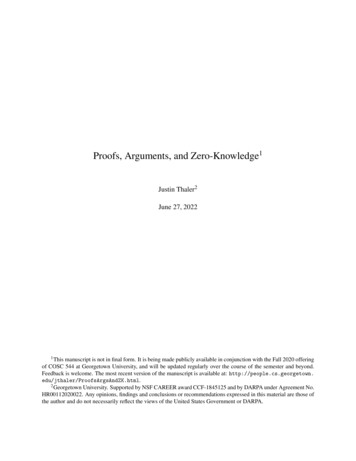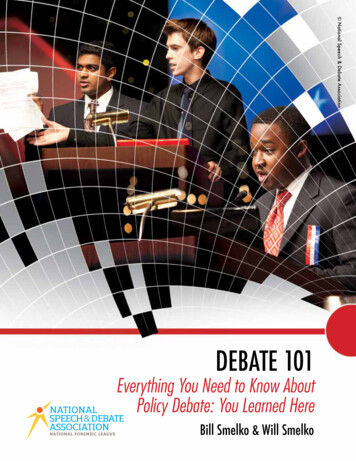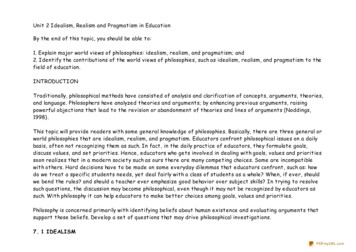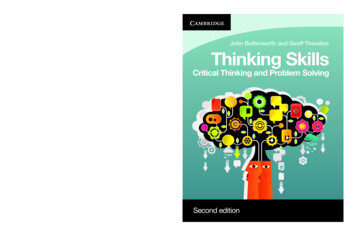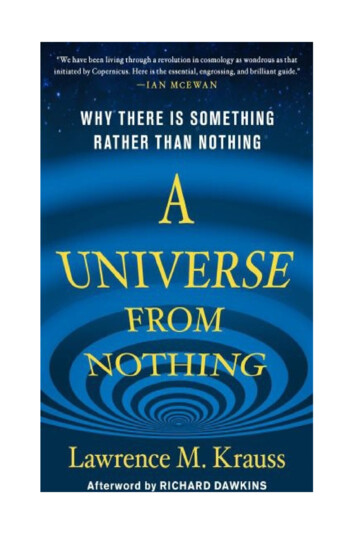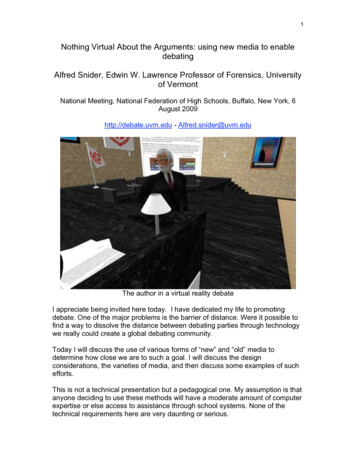
Transcription
1Nothing Virtual About the Arguments: using new media to enabledebatingAlfred Snider, Edwin W. Lawrence Professor of Forensics, Universityof VermontNational Meeting, National Federation of High Schools, Buffalo, New York, 6August 2009http://debate.uvm.edu - Alfred.snider@uvm.eduThe author in a virtual reality debateI appreciate being invited here today. I have dedicated my life to promotingdebate. One of the major problems is the barrier of distance. Were it possible tofind a way to dissolve the distance between debating parties through technologywe really could create a global debating community.Today I will discuss the use of various forms of “new” and “old” media todetermine how close we are to such a goal. I will discuss the designconsiderations, the varieties of media, and then discuss some examples of suchefforts.This is not a technical presentation but a pedagogical one. My assumption is thatanyone deciding to use these methods will have a moderate amount of computerexpertise or else access to assistance through school systems. None of thetechnical requirements here are very daunting or serious.
2PART I: DESIGNDebates that take place through these media needs to understand the limitationsof each media and the situations that the speakers and audiences are in.FORMAT Should be no more than an hour to facilitate audience engagement. Should not utilize cross-examination in some of the formats (streamingvideo, sequenced debates, etc.). Should utilize points of information only in some situations such as virtualreality. Should be adapted to debate formats students are already familiar with. Policy debate might be difficult because of the speed of delivery.LIVE OR SEQUENCEDLive debates: a debate happens all at once Plus: immediate, dynamic, save for on-demand viewing. Minus: time zones, technical glitches, full attendance required, hard togather an audience, coordination.Sequenced debates: one speech at a time, period of days or weeks Plus: easy to arrange and implement, speeches can be redone, technicalchallenges less of a problem. Minus: not so dynamic, must be edited for people to watch, problem offollow-through.JUDGING Regular contest judging: decision, critique. Audience judging: email, online poll Written ballot later.AUDIENCE No audience, just for the participants Live audience on site Live audience remote On-demand viewing audiencePART TWO: VARIETIESThere is not just one kind of new media debate. Through the use of variousmedia there are a number of possibilities.TEXT DEBATE Exchange written documents as text files or emails. Word limit Time limit – must be sequenced
3 Judges review final document setTech: Standard email and document attachment, sound -win.phpSOUND DEBATES Live debates with debaters in multiple locations Sequenced debates with central depository Problems with listeners chiming in Tech: voice recording software, QuickTime, Skype, Windows SoundRecorder.VIDEO DEBATESLive Debates: Camera, computer, encoder Connection, server, distribution (to web page or direct to player) Tech: QuickTime Broadcaster, Skype video phone, Windows Media,RealProducer.Sequenced Debates: Camera, computer, uploading Storage, editing, web distribution Tech: Vimeo video sharing service, video editing software.VIRTUAL REALITY DEBATES Example of using SecondLife – a virtual world Find virtual space to debate in Debaters create avatars, test out the space Voice through headset Can use cross-examination and points of information Audience can chat silently during the debate Audience gathers for the debate, watches & listens Judges can retire, discuss, return to the main room Can video and archive for on-demand viewingPART THREE: EXAMPLES:VERMONT-ESUFirst international online debate. Using QuickTime Broadcaster this debatebetween the University of Vermont and the English Speaking Union’s UK AllStars took place on 14 March 2000. At each site there was a large projectionscreen to show the relatively grainy images. Thousands watched the debate(mostly due to ESU’s promotion). Short video about this event is available athttp://www.uvm.edu/ debate/watch/VTUKDC.rm .WODC
4The World Online Debating Championships.This event is now going on. It is an example of text debating.“Debatewise is proud to announce the first ever World Online DebatingChampionships (or the WODC for short). This will be a debating competition likeno other, you can debate from the comfort of your chair, you can participateanywhere that has internet access, you'll have full 24 hours to perfect yourarguments and can collaborate with other people, no matter where they are inthe world.”http://www.debatewise.com/wodcIPPFThe International Public Policy ForumThis is an example of text debating that becomes live debating and is webcast.This is an excellent contest for high school students, costs nothing and offerssome large rewards. Teams debate through exchanged text files judged byuniversity debaters and lawyers. They advance through elimination rounds andthe top eight teams come to New York City for the final live debate judged by adistinguished panel of experts. The winner gets 10,000 and there are othergenerous cash awards as well.Facebook ational-Public-PolicyForum/211483875322?ref tsVideo Channelhttp://www.youtube.com/ippforumMain websitehttp://www.nppf.net/ST. JOHN’S-VERMONTSteve Llano of St. John’s University in New York City and the University ofVermont planned a debate in a complete virtual reality. It was held in SecondLife.St. John’s has a classroom and auditorium space that was used for the debate.The debate took place with a completely full room and many trying to get in. Fora first time technical event, it went off very smoothly. SecondLife is only for thoseeighteen and older. However, there is a teen second life.The promo for the event is ting-in-second-life.htmlVideo of the debate is h-first-debate-in-virtualreality.htmlA discussion of the debate is ond-life-debate-succeeds.html
5CONCLUSIONThere are many different ways in which we can use new media to dissolve thebarriers of distance and engage in educational, competitive and increasinglypublic debates. The challenge is to match modalities up with capacities andneeds to make this a satisfying experience. I believe it can and will be done.Previous Articles and EventsSnider, Alfred, “Debate Central on the Internet,” National Town Hall Meeting,Speech Communication Association Convention, New Orleans, November 1994.Snider, Alfred, "Netiquette for debaters," The Speaker (Journal of Delta SigmaRho-Tau Kappa Alpha Forensic Honorary Society), Spring, 1996.Snider, Alfred, World's first Internet distance debate, UVM vs. Cornell University,December 23, 1999. Viewed by people globally via UVM's streaming videocapability.Snider, Alfred, Web cast, Final Round (Emory vs. Michigan State), NationalDebate Tournament, March 2000, from Kansas City, MO, via UVM's streamingvideo capability.Snider, Alfred, World's first web cast of a competitive tournament debate, FinalRound (Michigan State vs. West Georgia), Cross Examination DebateAssociation national tournament, March 2000, from Overland Park, KS, viaUVM's streaming video capability.Snider, Alfred, World's first international distance debate, UVM vs. EnglishSpeaking Union (London, UK), March 14, 2000. Viewed by over 8000 computersglobally via UVM's streaming video capability and cooperation with LiveTX.comin Europe. Sponsored by Andersen Consulting, Burson-Marsteller, Apple, andPeoplesForum.com. Article in CHRONICLE OF HIGHER EDUCATION, March31, 2000, p. A51.Snider, Alfred, "Internet Debating: A New Age Dawns," The Rostrum, June 2000.Snider, Alfred, Web cast, Final round events from National Forensic Leaguenational tournament, Portland, OR, June 2000, via UVM's streaming videocapability.Snider, Alfred, "Internet Debating: the USA Perspective," at International DebateEducation Association Conference 2000 (Debate and Argumentation: OpeningMinds, Borders, and Societies), Budapest Hungary, October 6-8, 2000.
6Snider, Alfred, “Videoblog Debating: the next phase,” International Conferenceon Argumentation, Rhetoric, Debate and the Pedagogy of Empowerment,November 24-26 2006, Koper, Slovenia.Snider, Alfred, Web cast, Final round events from National Forensic Leaguenational tournament, Las Vegas, June 2008, via UVM's streaming videocapability.Snider, Alfred, Web cast, Final round events from National Forensic Leaguenational tournament, Birmingham, Alabama, June 2009, via UVM's streamingvideo capability.Snider, Alfred, “Internet debating: technical solutions for the early 21st Century,”Contemporary Argumentation and Debate, me/QuickTime ttp://www.skype.com/download/skype/macosx/Teen Second ww.vimeo.com/Windows /forpros/broadcast.aspx
7Model of a live streaming video debate from 2004
Speech Communication Association Convention, New Orleans, November 1994. Snider, Alfred, "Netiquette for debaters," The Speaker (Journal of Delta Sigma Rho-Tau Kappa Alpha Forensic Honorary Society), Spring, 1996. Snider, Alfred, World's first Internet distance debate, UVM vs. Cornell University, December 23, 1999. Viewed by people globally via .


